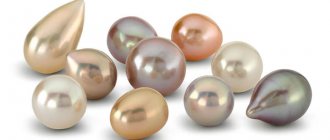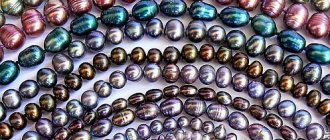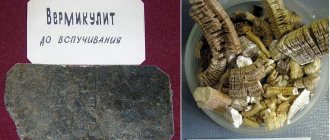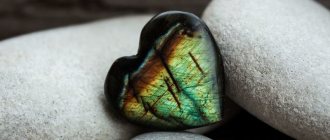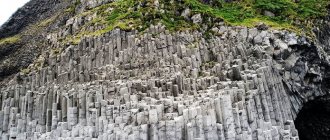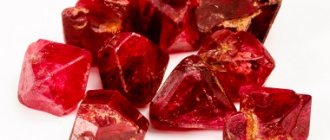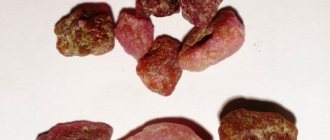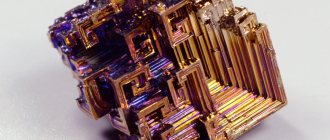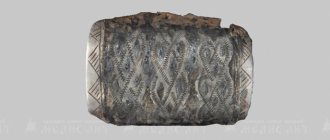Amber, also known as alatyr or amber, has long been used for making jewelry and various crafts. Vases, boxes, and decorative panels made of amber decorated the houses of wealthy merchants and royal halls; amber beads were a favorite gift for peasant girls and noblewomen; everyone liked the semiprecious stone. What attracted attention to the “tears of the sea”? Which stones were most valued?
The very origin of amber is surprising; according to some scientists, the mineral was formed only in those places where huge tracts of coniferous forest bordered the seas and lakes. In prehistoric times, those areas were characterized by a tropical and subtropical climate.
Only the resin instantly cooled by the waters turned into sunny amber “drops”. It is believed that if viscous pine sap fell on dry stones under a tree, it spread, dried out, cracked and turned into dust over time. Only those resin deposits that immediately fell into the sea have reached us.
How and when did insects get into amber?
It is amazing to see that, judging by the size of some of the resin secretions, coniferous trees were much taller and stronger than those existing today. The increased amount of oxygen in the air, characteristic of those times, proves this assumption.
How was it established that there was more oxygen during the Paleogene period? It turns out that when insects and plants fell into drops of amber resin, they captured a piece of the atmosphere. After millions of years, scientists were able to perform a spectral analysis of amber bubbles and find out the exact composition of the components of prehistoric air.
How did insects, plants, and animals get inside the amber captivity? It has been noticed that if an insect is grouped in a stone, its legs and wings are close to each other, it entered the mineral already dead. Resisting butterflies, spiders, and dragonflies, captured by resin, have their wings spread out and their legs spread to the sides.
Who is usually found inside amber drops?
Most of the organisms found in amber belong to flying representatives of the fauna, which is an argument in favor of the version of insects and other animals accidentally falling into falling resin drops. Amber captives have been stored in stones since ancient times; there are finds ranging in age from 30 to 230 million years and older.
It is impressive that under a microscope you can see a prehistoric animal in its full surroundings, without any changes, as it was millions of years ago. Who was imprisoned in amber?
- Mosquitoes. Apparently the pleasant resinous aroma attracted these dipterous insects; their number in the already found stones is very large. Moreover, the fact that they are located freely in the resin, with their legs and wings spread out, indicates that the resin was quite liquid, but sticky and left no chance of getting out.
- Butterflies. Incredibly, the wings of the insects did not change their structure, preserved in amber in their original form, including color. Amber fossils are fascinating precisely because they preserve such fine detail of prehistoric organisms.
- Ants. Entire colonies of small insects are found in the stone; thanks to amber storage facilities, scientists were able to identify more than three thousand species of prehistoric insects, about two hundred new species of plants, previously unknown.
- Snails. The size of most small animals captured by resin does not exceed 4 mm; among them, representatives of gastropods are quite rare.
- Scorpions and other arthropods. Such finds are especially in demand on the amber market; collectors are willing to pay thousands of dollars for a prehistoric scorpion preserved in amber resin.
Many spiders, dragonflies, praying mantises, stick insects, and even fleas were carelessly stuck in the viscous and sticky pine resin, which allowed researchers to assume that warm-blooded mammals already existed in these places at that time.
The most unexpected discovery in recent years was amber from Burma. Traders assured Chinese scientists that the feathers of an unknown bird were imprinted in the resin. Upon detailed study of the acquired mineral, it turned out that the tail of a dinosaur had ended up in the resin prison. Rarely, small vertebrates are found in the resin: lizards, frogs.
Insects in amber or “amber with inclusions” (11 photos)
Author: Maryivanna
21 February 2022 16:43
Tags: Amber inclusion history insects paleontology decoration
3768
11
Amazing insects in amber, which lived several tens or even hundreds of millions of years ago, have been valued throughout the entire existence of mankind on Earth. Even in Ancient Egypt, some specimens of such fossils (especially if a large or rare arthropod was frozen in amber) could cost a fortune.
0
See all photos in the gallery
Today, amber with inclusions is valuable not only for collectors, but also for paleontologists, because with the help of “images of prehistoric eras” one can study changes in the earth’s atmosphere, flora and fauna.
0
The very name of inclusion came into use thanks to the French word inclusif, translated meaning “including.” Over several centuries, inclusions were found in various parts of the planet, and their contents were sometimes amazing - in addition to mosquitoes, midges and flies, lizards and, very rarely, even small vertebrates were found in amber. Often, researchers found amber with plant elements, feathers, and wool.
×
0
To create an inclusion, the insect or animal not only had to get stuck in the resin, but the material itself had to harden quickly enough, for example, when it got into water. That is why amber with inclusions is most often found in the tropics and subtropics, as well as in places where forests border the sea.
0
A mosquito or a fly in amber has become generally accepted symbols of expensive inclusion, however, such specimens can be called mediocre to some extent. Even more common are pieces of the mineral with tiny air bubbles, which give the fossil only aesthetic rather than market or historical value. Another thing is scorpions, frogs, lizards and small mammals stuck in resin. Such specimens of inclusions are found very rarely, and their cost can be several tens of thousands of dollars.
0
The largest inclusion with an amphibian was found in the Dominican Republic in the late 90s of the last century. A small frog, forever frozen in resin, was valued at $50,000.
0
Inclusions provide paleontologists and archaeologists with a unique opportunity to study events and changes in the biosphere that occurred tens and hundreds of millions of years ago. Even the most ordinary fly in amber, surrounded by air bubbles and plant particles, can shed light on the climate in a particular corner of the planet, tell about the evolution of insects in general, as well as the characteristic features of the flora.
0
A big advantage of the mineral is the fact that all inclusions have been preserved to this day almost in their original form - this is due to the fact that the resin gently but quickly enveloped all foreign objects that fell into it, forming a durable and beautiful-looking cocoon. Thus, thanks to the properties of amber, scientists were able to simulate the behavior between predator and prey in prehistoric times, when they discovered a piece of the mineral with a scorpion and a beetle. Insects in yanatra Viscous resin, which contains ant colonies and insect larvae, can not only tell biologists and paleontologists about the features of prehistoric fauna, but also help rediscover species that disappeared millions of years ago. At the moment, thanks to fossilized amber, about 3 thousand species of insects that lived on Earth in the Triassic and Jurassic periods, as well as 200 species of plants, have been found.
0
On average, the age of found amber with inclusions varies between 50–70 million years. The most ancient specimens are found in Austria and the Dominican Republic.
0
Most often, the minerals contained flying representatives of the fauna, namely midges, beetles, mosquitoes, dragonflies, cicadas and small butterflies (more than 50 species of the latter were found). Many specimens with such insects have almost completely preserved the appearance of their “captives,” so collectors often try to buy back these inclusions. Thanks to the parasitic insects found in amber, scientists can conclude that other, larger representatives of the fauna live in the same territory. For example, inclusions in the form of fleas found in Baltic minerals indicate that warm-blooded animals previously lived here. Using scraps of wool and feathers found in amber, you can also model interesting theories and provide evidence.
0
Today, most of the valuable inclusions are contained either in private collections or in several museums scattered around the world. In Russia, the Kaliningrad Museum is considered the largest exhibition of amber, where tens of thousands of inclusion exhibits are presented, which can be carefully examined using a magnifying glass. At the Amber Museum in Gdansk, you can also plunge into prehistoric times, admiring quite rare specimens, for example, a lizard frozen in amber, just over 4 cm long and about 55 million years old. One of the largest private collections can be called the collection of Yuri Pedorenko, a Russian businessman. Over the course of a decade and a half, he added more than 3,500 inclusion exhibits to his “small” museum.
0
Source:
More cool stories!
- I seem to have a new hobby: an unusual hobby of a Briton
- How to make money on human complexes: the story of the American Xavier Long
- An 11-year-old man was bedridden and cured himself
- 10 unusual dinners for suicide bombers
- The job of a car mechanic is full of surprises.
Tags: Amber inclusion history insects paleontology decoration
Did you like the post? Support Chips, click:
72 1 71
Liked
71 1
1
Partner news
Where are amber with inclusions most often found?
Currently, the largest discovered field on earth is the Baltic, about 80% of the world's reserves. Most inclusions of northern stone are small insects, plant remains, and air bubbles.
The most interesting finds are amber from Myanmar (Burma). Inclusions of small insects, arthropods, and arachnids of Burmese origin decorate the amber of many collectors. However, in fairness, we note that the remains of fossil animals can be found in any amber. The most ancient ones are found near the Austrian city of Luntz, their approximate age is 225-231 million years. The Cretaceous period is studied from minerals from Lebanon - 125 million years old. Canadian amber from Cedar Lake near Manitoba has been preserved in the waters for 75 million years. The most beautiful butterfly in amber was found in the Dominican Republic.
TOP 10 Unusual finds preserved in amber
Millions of years ago, trees oozed sticky resin that retained everything that fell into it. When frozen, the resins turned into amber and carried moments of the prehistoric era through millions of years. Animals and plants extracted from amber provide us with invaluable information about life in ancient times.
What continent do ants come from, what flower did ancient bees pollinate, and why can’t DNA be extracted from a Jurassic mosquito? All these questions can be fully or partially answered by amber. Although in the famous film by Steven Spielberg, it was amber that provided the answer to the question “why can DNA be extracted from a mosquito.” It’s even a pity that cinema and life are two different things!
It is impossible to extract DNA from a mosquito that has drunk the blood of a dinosaur, no matter what Jurassic Park tells us about it. Scientists tried this trick with insects frozen in copal, a relative of amber, and failed miserably. DNA does not “survive” in a structure stored for 60 to 10,000 years, let alone amber tens of millions of years old?
Sixteen million years ago, a “fellow traveler” - a springtail, clinging to its antennae - clung to the back of an adult mayfly. The couple fell into the resin and survived to this day, which surprised scientists a lot. Before this, not a single species of animal was known to use the mayfly as a means of transportation. Perhaps springtails continue this practice today, they are just extremely difficult to detect.
Air bubbles preserved in amber allowed us to make an important discovery - in the time of dinosaurs, the air was much more saturated with oxygen. In the Cretaceous period, 67 million years ago, there was 14% more oxygen, but during the transition to the Tertiary period its level decreased significantly. This coincided with the extinction of the dinosaurs - perhaps an oxygen-rich atmosphere was necessary for them.
A 100-million-year-old piece of amber from Myanmar was found to contain a fossilized herb containing a psychotropic fungus, Palaeoclaviceps parasiticus, similar in action to ergot. Those. causing hallucinations, severe pain, convulsions and gangrene not only in humans, but also in herbivores. It is possible that dinosaurs ate grass with fungus, but what effect this had was not fully known.
The haymaker frozen in amber, a close relative of modern spiders, died about 100 million years ago and was almost no different from modern representatives of its order. While the dinosaurs went extinct as a result of an asteroid impact 65 million years ago, the haymakers appear to have survived the disaster without any problems.
It was believed that the Indian subcontinent broke away from Antarctica 150 million years ago and “drifted” on its own until it landed in Asia another 100 million years later. The study of amber has shaken this theory. Over 100 million years, new species should have formed, but all 700 insects and arachnids from Indian amber turned out to be related to fossils from Europe, Australia and the tropics of America.
Initially, North America and southern Asia were called the homeland of ants, since fairly ancient fossils were found only there. The new discovery has added another destination - Ethiopia, along with a new species of ant that is 95 million years old. Ancient insects, spiders, ferns and mushrooms that existed during the Cretaceous period were also discovered.
Twenty million years ago, a bee collecting pollen found itself trapped in a resin trap. The pollen, carefully studied in 2005, was identified as orchid pollen. This discovery not only proved that orchids are older than thought, but also older than all other flowering plants.
In two pieces of amber purchased at a market in Burma, scientists discovered the preserved remains of wings with feathers - 100 million years old. Perhaps they belonged to Enantiornis, one of the most ancient birds. Before that, only feather imprints were found in amber. Judging by the break in one of the pieces, there was a piece of amber with a whole bird frozen in it, but it was lost forever.
Finding feathers from ancient birds is one thing, but feathers from flightless dinosaurs is another. But it was they who were discovered in amber from Alberta, 80 million years old, in almost all forms of development - from fur to feathers. They were not designed for flight, but rather for swimming. And yes, they covered many of the dinosaurs we know of, even those we never thought about in that way.
Who is interested in animals trapped in amber?
Amber curiosities have attracted humanity at all times; it is a known historical fact that a Phoenician merchant paid for Baltic amber with an inclusion in the form of a whole fly with 120 swords and 60 daggers. In ancient times, special magical and healing properties were attributed to amber, otherwise how would amber get from the Baltic to the tombs of the Egyptian pharaohs? He was valued and hunted.
At the beginning of the 19th century, amber with inclusions became especially popular among the noble nobility of France and Russia. Being known as the owner of interesting curiosities was popular and prestigious.
Nowadays, priorities have changed somewhat; of course, collectors are still ready to pay thousands of dollars for a frog in amber. But the main value is the scientific side of the finds. Paleontologists and archaeologists, using modern high-tech equipment, have a unique opportunity to study the events that took place on Earth millions of years ago:
- find out the composition of the biosphere in prehistoric times;
- discover unstudied species of animals and plants;
- create an accurate description of evolutionary changes;
- determine the climatic features of different parts of the planet during the Mesozoic period.
Collections of inclusions. Where to look?
Previously, the largest collection of inclusions in the world was located in the Albertina. Now parts of this collection, which included about 100 thousand copies, are scattered across museums around the world.
In the Kaliningrad Amber Museum, inclusions could previously only be seen in photographs. But recently the museum was allocated the funds necessary to replenish its funds. Almost a million rubles were allocated to the museum from the regional budget. Before choosing worthy samples, museum staff examined and evaluated about 150 kilograms of amber with inclusions - that’s almost ten thousand stones from a variety of private collections. As a result, more than 2 thousand units of amber with inclusions were purchased. Museum visitors can examine 70 new exhibits more closely under a magnifying glass.
Among the museum's new exhibits there are truly unique ones. For example, a lizard more than four centimeters long is more than 50 million years old. There are no such exhibits in Russian museums; a similar one is available only in the Amber Museum in Gdansk, Poland.
How to distinguish a fake from a real stone
There is a whole industry that skillfully counterfeits amber mineral with inclusions. The fashion for unusual stones has provoked a whole stream of fraud.
Ways to distinguish a fake from a real natural formation:
- in a real stone, the insect is in an “uncomfortable” position, a beautiful scorpion in a mineral as transparent as a tear is more likely a fake, a real one is usually twisted, broken and not so elegant;
- irradiation with UV rays will immediately reveal the artificial plastic, it will not change, and natural amber will shimmer with multi-colored rays.
The main rule for competently purchasing amber jewelry is to contact a specialized network. The website amberika.ru has been selling amber jewelry for many years. Our impeccable reputation is a guarantee of an honest and clean transaction!
Expensive or cheap stone?
Mined amber is small round stones, with an average diameter of 30 millimeters. But also in amber mines there are pieces of amber, the mass of which is 4-7 kilograms, although such a find is considered rare. As for the color of amber, it can be very different. The most common stone is a sunny yellow color. Also found in nature is a stone of white-yellow and red color.
Amber with an insect inside (inclusion)
Several thousand years ago, amber was considered a precious stone, so only rulers of states could afford it. For example, in Egypt, during the time of the pharaohs, amber products were considered attributes of luxury, but only for the reason that the places where the stone was mined were located thousands of kilometers from Egypt itself.
Over time, humanity discovered numerous amber mines, which to this day are located on the territory of the modern Baltic countries, as well as in Russia and Ukraine. First, the discovery of new mines led to a reduction in the price of stone, which made it an accessible raw material for the production of jewelry. However, relatively recently the price for 1 gram of amber began to rise rapidly, and this trend has been observed for the last 3-5 years. Why has amber become so expensive and how much does 1 gram of such a stone cost today?
There is an opinion that the cost of amber began to rise due to the inexplicable excitement caused by the demand for this stone. For example, today inexpensive inserts into jewelry can be made from amber, which are in demand among buyers. The supply of the resource in the relevant market is also very high, and all because the extraction of amber does not require the use of modern technologies and special knowledge.

